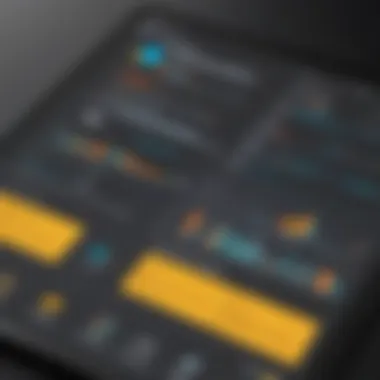A Comprehensive Analysis: Tableau vs. Power BI - Which Data Visualization Tool Reigns Supreme?


Technological Research Overview
As we delve into the realms of data visualization tools, a keen eye is required to grasp recent technological innovations in platforms like Tableau and Power BI. These tools are revolutionizing business operations through their intricate features and capabilities. Moreover, analyzing these tools’ impact on business operations brings to light the essence of staying abreast with future technological trends for sustained relevance and competitiveness in the data analytics landscape.
Data Analytics in Business
Recognizing the pivotal role of data analytics in modern business settings, understanding the importance of harnessing data power is paramount. Unveiling the various tools available for data analysis sheds light on the diverse approaches businesses can embrace for informed decision-making. Furthermore, delving into case studies that illustrate data-driven decisions showcases the tangible benefits of leveraging robust data analytics platforms like Tableau and Power BI.
Cybersecurity Insights
A critical aspect that cannot be overlooked is comprehending the ever-evolving threat landscape in the cyberspace. Conducting a meticulous analysis of cybersecurity threats helps in formulating best practices to fortify digital defenses. Additionally, ensuring regulatory compliance in cybersecurity endeavors safeguards businesses from potential data breaches and regulatory penalties, underpinning the significance of a robust cybersecurity framework.
Artificial Intelligence Applications
The integration of AI in business processes signifies a paradigm shift towards greater automation efficiencies. Exploring the various AI algorithms and applications underscores the extensive capabilities AI brings to the table. Moreover, navigating ethical considerations in AI application necessitates a delicate balance between technological advancement and upholding core ethical principles within business operations.
Industry-Specific Research
Taking a tailored approach to industry-specific research propels us into varied sectors such as finance, healthcare, and retail. Examining technological research within the finance sector unveils the cutting-edge solutions driving financial operations towards digitization. The healthcare industry's technological advancements highlight the transformative impact of innovative tech solutions on patient care and operational efficiencies. Similarly, exploring tech solutions in the retail industry showcases the strategic integration of technology to enhance customer experiences and streamline operations.
Introduction
In the realm of data analytics, the choice between Tableau and Power BI holds significant importance. Selecting the right data visualization tool can greatly impact the way organizations visualize and interpret data. Tableau and Power BI stand out as two key players in this field, each offering unique features and capabilities that cater to diverse analytical needs and requirements. Understanding the nuances between these platforms is crucial for professionals and businesses seeking to harness the power of data effectively.
Overview of Tableau and Power BI
When delving into the arena of data visualization tools, Tableau and Power BI emerge as stalwarts in the field, known for their robust functionalities and user-friendly interfaces. Tableau boasts a reputation for its intuitive dashboarding capabilities and sophisticated visualizations, enabling users to transform complex datasets into interactive and compelling visuals. On the other hand, Power BI, developed by tech giant Microsoft, is celebrated for its seamless integration with other Microsoft products, providing a familiar environment for users already accustomed to Microsoft's ecosystem.
Significance of Data Visualization Tools
Data visualization tools play a vital role in modern-day decision-making processes across industries. These tools empower users to unearth insights from vast pools of data, enabling them to make informed decisions based on precise analysis and interpretation. Real-time visual representations of data enhance understanding and facilitate seamless communication of findings within an organization. Tableau and Power BI epitomize the evolution of data visualization tools, offering cutting-edge features that simplify complex data analysis and drive innovation in areas such as business intelligence, data analytics, and visual reporting.
Features and Capabilities
In the realm of data visualization tools, the features and capabilities hold paramount importance, serving as the bedrock of user experience and functionality. In this exhaustive comparison between Tableau and Power BI, understanding these elements becomes crucial for decision-makers and tech enthusiasts. Features encompass a wide array of tools and functions that streamline data analysis, from interactive dashboards to advanced data connectivity options. Capabilities refer to the tool's potential to handle diverse data sources efficiently and provide insightful visualizations. When evaluating Tableau and Power BI, considerations around the depth of features, flexibility in customization, and the scalability of capabilities are pivotal. These aspects play a vital role in determining the tool's suitability for various business needs, aiding in selecting the most effective data analytics platform.


Interactive Dashboards
Interactive dashboards are a cornerstone in data visualization, allowing users to manipulate and explore data dynamically. When comparing Tableau and Power BI, the interactive dashboard functionality emerges as a critical factor for enhancing data interpretation and decision-making processes. Tableau's interactive dashboard interface offers a seamless experience for users, with intuitive drag-and-drop features and real-time data updating capabilities. On the other hand, Power BI provides robust interactivity through customizable widgets and drill-down options, empowering users to delve deeper into the data. Evaluating the interactive dashboard features of both tools enables businesses to choose a platform that aligns with their data visualization requirements and analytical workflow.
Data Connectivity Options
Data connectivity lies at the core of data analytics tools, facilitating seamless integration with various data sources. In the context of Tableau and Power BI, exploring the different data connectivity options is essential for optimizing data access and analysis. Tableau offers extensive support for diverse data sources, including cloud databases, spreadsheets, and big data platforms, ensuring comprehensive connectivity for users. Conversely, Power BI leverages powerful connectors to access data from multiple sources, enabling users to create unified datasets for analysis. By delving into the data connectivity features of Tableau and Power BI, organizations can streamline their data integration processes and harness the full potential of their data assets.
Collaboration and Sharing Features
Collaboration and sharing functionalities are pivotal for fostering a data-driven culture within organizations, enabling seamless communication and knowledge sharing among team members. When comparing Tableau and Power BI, assessing the collaboration and sharing features unveils the tools' capabilities in fostering teamwork and accelerating decision-making. Tableau offers robust collaboration features, allowing users to share interactive dashboards, workbooks, and visualizations with stakeholders effortlessly. In contrast, Power BI facilitates collaborative workflows through built-in sharing options and secure data sharing capabilities. Understanding the collaboration and sharing functionalities of Tableau and Power BI assists businesses in establishing efficient data exchange practices and driving collaborative data-driven initiatives for enhanced organizational outcomes.
User Interface and Ease of Use
User Interface (UI) and ease of use play a pivotal role in the comparison of Tableau and Power BI within this comprehensive analysis. The UI of a data visualization tool impacts user experience, efficiency, and intuitiveness. A well-designed UI can streamline workflows, enhance productivity, and facilitate quicker decision-making processes for professionals and businesses.
Effective dashboard design and customization further amplify the significance of UI, allowing users to tailor visualizations to specific needs. Tableau's interface stands out for its user-friendly design, offering robust customization options and intuitive drag-and-drop features. The dynamic nature of Tableau's interface empowers users to create interactive and engaging dashboards effortlessly, driving impactful data analysis and insights.
On the other hand, Power BI's interface boasts seamless integration with Microsoft products and services, catering to users familiar with the Microsoft ecosystem. The interface is known for its ease of use and accessibility, enabling quick adoption and minimal training requirements for users transitioning from other Microsoft tools. While Power BI provides a straightforward interface for data visualization, some users may find customization options comparatively limited, impacting the extent of tailored dashboard designs.
Dashboard Design and Customization
Tableau's Interface
Tableau's interface excels in providing a visually appealing and highly interactive platform for data visualization. One key characteristic of Tableau's interface is its drag-and-drop functionality, allowing users to effortlessly build custom dashboards without the need for complex coding or programming skills. This intuitive feature accelerates dashboard creation processes, enabling users to focus on interpreting and analyzing data rather than navigating intricate design tools.
A unique feature of Tableau's interface is the seamless blending of different data sources, facilitating comprehensive data analysis encompassing multiple datasets. This capability enhances data integration and enables users to derive meaningful insights from diverse data points efficiently. However, one potential drawback of Tableau's interface lies in its initial learning curve for new users due to the extensive array of features and functionalities to explore.
Power BI's Interface
In contrast, Power BI's interface emphasizes user-friendliness and familiarity for individuals accustomed to Microsoft's interface conventions. The key characteristic of Power BI lies in its seamless integration with other Microsoft applications, offering a cohesive user experience within the Microsoft ecosystem. This integration streamlines data connectivity across various Microsoft platforms, enhancing data accessibility and interoperability.
A unique feature of Power BI's interface is the user-friendly drag-and-drop interface, simplifying dashboard customization and report creation for users at all levels of expertise. However, while Power BI provides a smooth and intuitive interface, some users may find the customization options relatively limited compared to Tableau, restricting the extent of intricate dashboard designs.
Learning Curve and Training Resources


To aid users in navigating the intricacies of Tableau and Power BI interfaces, comprehensive learning resources and training materials are vital. The learning curve of each tool significantly impacts the efficiency and productivity of users, influencing their overall experience with the software.
Tableau offers an extensive range of training resources including tutorials, webinars, and a vibrant user community. These resources support users in mastering Tableau's interface, functionalities, and best practices, empowering them to leverage the full potential of the tool effectively. While Tableau's steep learning curve may pose initial challenges, the abundance of training materials ensures continuous learning and skill enhancement for users.
In comparison, Power BI provides a seamless learning curve for users familiar with the Microsoft ecosystem. The tool's integration with Microsoft products enhances familiarity and simplifies the onboarding process for users already proficient in Microsoft software. Additionally, Power BI offers a variety of online tutorials, documentation, and knowledge bases to support users in navigating the tool efficiently. The intuitive nature of Power BI facilitates swift adaptation, enabling users to harness its capabilities swiftly and effectively.
Data Connectivity and Integration
In the realm of data analytics, the aspect of data connectivity and integration holds immense significance. It serves as the backbone that allows organizations to harness the full potential of their data. Data connectivity refers to the ability of a tool to access and retrieve data from various sources, while data integration focuses on combining and consolidating data from disparate systems into a unified view. When comparing Tableau and Power BI, evaluating their data connectivity and integration capabilities becomes paramount. Businesses need to consider the ease of connecting to different data sources, the flexibility to integrate diverse datasets, and the efficiency of real-time data synchronization. A robust data connectivity and integration framework ensures seamless access to updated information for informed decision-making, facilitates comprehensive data analysis, and streamlines reporting processes.
Data Sources Compatibility
Data sources compatibility plays a pivotal role in the effectiveness of a data visualization tool. Tableau and Power BI offer support for a wide array of data sources ranging from databases, cloud services to big data platforms. Tableau's interoperability with numerous data formats and databases allows users to access and analyze data from various sources with ease. On the other hand, Power BI's seamless integration with Microsoft products and services enhances compatibility and data connectivity for users operating within the Microsoft ecosystem. Understanding the data sources compatibility of Tableau and Power BI is imperative for users to ensure their data infrastructure aligns with the capabilities of the chosen analytics platform, enabling smooth data integration and analysis.
Integration with External Platforms
Integration with external platforms amplifies the functionalities of data visualization tools by extending their scope and reach. Both Tableau and Power BI offer integrations with a plethora of external platforms including CRM systems, ERP software, cloud services, and business intelligence tools. These integrations empower users to leverage additional functionalities, access enriched data sets, and streamline workflows by connecting data visualization tools with other business applications. Evaluating the integration capabilities of Tableau and Power BI enables organizations to identify synergies with existing systems, maximize operational efficiency, and drive data-driven decision-making across the enterprise.
Real-time Data Streaming
Real-time data streaming capability is vital for organizations that rely on up-to-the-minute data insights for swift decision-making. Tableau and Power BI differ in their approaches to real-time data streaming, with Tableau offering robust integration with streaming services like Kafka and Google BigQuery for instantaneous data processing. Power BI, on the other hand, emphasizes real-time data visualization through its live connection feature, allowing users to view data updates as they occur. Understanding the nuances of real-time data streaming in Tableau and Power BI aids organizations in selecting the right tool that aligns with their data processing requirements, ensuring timely insights and actionable intelligence for accelerated business operations.
Performance and Scalability
Performance and scalability are crucial aspects when comparing Tableau and Power BI in this comprehensive analysis. Effective performance ensures smooth operation and quick access to data insights, enhancing decision-making processes. Scalability, on the other hand, pertains to the ability of a system to accommodate growth without compromising performance. In this context, examining the capabilities of both Tableau and Power BI in terms of handling increasing workloads and complex data plays a pivotal role.
Speed and Processing Efficiency
Speed and processing efficiency are key components in evaluating data visualization tools like Tableau and Power BI. The speed of processing data impacts the time taken to generate reports and visualizations, directly influencing user experience and productivity. Furthermore, processing efficiency dictates how effectively the tools handle data manipulation, calculations, and rendering visual elements. Understanding the speed and processing efficiency of Tableau and Power BI allows users to streamline their analytical tasks and derive quicker insights.
Handling Large Datasets
Another critical consideration when comparing Tableau and Power BI is their capability in handling large datasets. As organizations deal with an ever-increasing volume of data, the ability of a visualization tool to manage and analyze extensive datasets becomes paramount. Evaluating how Tableau and Power BI manage data storage, retrieval, and processing for large-scale datasets provides valuable insights into their suitability for data-intensive tasks. Effective handling of large datasets determines the tool's performance when dealing with substantial information, influencing the overall data analysis process.
Pricing and Licensing


In the realm of data visualization tools like Tableau and Power BI, Pricing and Licensing stand out as crucial considerations. Businesses and professionals exploring these tools must delve into the intricacies of pricing structures and licensing models to make informed decisions. Pricing directly impacts budget allocations and cost-effectiveness, while licensing terms determine the usage rights and limitations imposed on the software. Understanding the nuances of Pricing and Licensing ensures that organizations optimize their investments and avoid unexpected costs.
Subscription Models
Subscription models play a pivotal role in the accessibility and usability of data visualization platforms like Tableau and Power BI. These models dictate how users acquire and utilize the software, whether through monthly or annual subscriptions. The flexibility offered by different subscription tiers allows businesses to adapt their usage based on varying needs and budget constraints. By delving into the specific features and limitations of each subscription model, users can align the software's offerings with their operational requirements, thereby maximizing utility and cost efficiency.
Cost Comparison
A detailed cost comparison between Tableau and Power BI is essential for decision-makers evaluating these data visualization tools. By meticulously dissecting the pricing structures, feature set, and scalability options of each platform, organizations can determine the total cost of ownership and return on investment. Beyond the initial acquisition costs, a comprehensive cost comparison considers long-term expenses, maintenance fees, and additional services required for optimal functionality. This analysis enables stakeholders to make strategic choices that align with their financial objectives and operational capabilities, paving the way for a seamless integration of the chosen data analytics platform.
Industry Applications
In the realm of data visualization tools, industry applications play a pivotal role in shaping the efficacy and versatility of platforms like Tableau and Power BI. In this article, our focus shifts to how these tools are leveraged across various sectors to derive valuable insights and strategic decision-making. Industry applications serve as practical demonstrations of how business intelligence tools translate data into actionable intelligence.
Business Intelligence
The concept of business intelligence encapsulates the process of collecting, analyzing, and presenting key business information to facilitate informed decision-making. Within the context of Tableau and Power BI, business intelligence capabilities are instrumental in transforming raw data into coherent narratives that aid stakeholders in unraveling complex operational challenges and opportunities.
Data Analytics
Data analytics embodies the practice of examining datasets to discern patterns, draw conclusions, and support organizational strategies. In the realm of Tableau versus Power BI, data analytics capabilities are paramount in augmenting predictive modeling, trend analysis, and forecasting functionalities to empower users in making data-driven decisions with precision and confidence.
Visual Reporting
Visual reporting stands at the apex of data visualization tools, showcasing data insights through visually appealing and comprehensible means. For both Tableau and Power BI, the ability to craft compelling visualizations, intuitive dashboards, and interactive reports is a cornerstone in elucidating complex data relationships, trends, and patterns for enhanced stakeholder engagement and comprehension.
Conclusion
In the realm of data visualization tools and analytics platforms, arriving at a comprehensive conclusion after an in-depth comparison between Tableau and Power BI is paramount. The conclusion section serves as the culmination of a meticulous analysis focusing on various facets like features, pricing structures, user interfaces, data connectivity options, and industry applications of both Tableau and Power BI. Through this evaluation, professionals, entrepreneurs, decision-makers, and tech enthusiasts gain invaluable insights into the strengths and limitations of each tool, aiding them in making informed choices for their businesses or projects. The importance of the conclusion lies in providing a final verdict based on a detailed examination of all relevant aspects covered in the article, guiding readers towards a judicious selection between Tableau and Power BI.
Key Takeaways
As we dissect the intricacies of Tableau and Power BI, several key takeaways emerge that are pivotal for decision-makers embarking on selecting a data visualization tool. Firstly, the robust features of Tableau, such as interactive dashboards and extensive data connectivity options, offer a high level of flexibility and sophistication in data representation. Conversely, Power BI's seamless integration with other Microsoft products and services could be advantageous for organizations within the Microsoft ecosystem. Understanding these nuanced differences empowers users to align their specific requirements with the capabilities of each platform effectively.
Moreover, in terms of pricing and scalability, Tableau's diverse subscription models cater to various budgetary constraints, while Power BI's cost-efficient structure makes it an attractive option for small to medium enterprises. This juxtaposition underscores the importance of assessing not only the current needs but also future scalability and cost implications when making a choice between Tableau and Power BI. These key takeaways distilled from the comparison analysis provide a strategic framework for users to navigate the complexities of data analytics tools efficiently.
Final Recommendations
In the conclusive segment of our analysis, delineating final recommendations for choosing between Tableau and Power BI becomes imperative. Considering the user interface and ease of use, organizations inclined toward a more user-friendly and intuitive design may find Power BI more accessible, whereas power users seeking advanced customization options and intricate dashboard designs may lean towards Tableau. The tailored training resources and learning curves associated with each platform play a pivotal role in determining the ease of adoption and utilization within an organization.
Furthermore, organizations with a focus on real-time data streaming and integration with external platforms should weigh the advantages of Power BI's seamless ties with Microsoft ecosystem against Tableau's versatility and compatibility with diverse data sources. The performance and scalability benchmarks of both tools must also align with the organization's data processing requirements to ensure optimal usability and efficiency. Crafting final recommendations based on these detailed evaluations ensures that businesses and professionals can make an informed decision that aligns with their specific needs and long-term strategic objectives.







